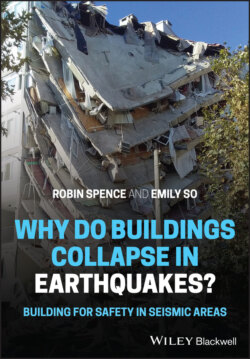Читать книгу Why do buildings collapse in earthquakes? Building for safety in seismic areas - Robin Spence - Страница 10
1 Introduction: Why This Book 1.1 Earthquakes – An Underrated Hazard
ОглавлениеEarthquakes have been a threat to human habitation throughout history, but until relatively recently, their causes were poorly understood. In the pre‐scientific era, they were commonly ascribed to divine intervention. By the time of the Lisbon earthquake in 1755, there were many who understood that earthquakes had natural causes, but the mechanism remained unexplained, and the supernatural explanation was widely proclaimed, especially from church pulpits (Udias and Lopez Arroyo 2009). And over 150 years later, according to observer Axel Munthe (1929), the inhabitants of Messina, destroyed by a massive M7 earthquake in 1908, cried ‘Castigo di Dio’ (‘punishment from God’).
Only with the development of plate tectonics in the twentieth century has it become understood that earthquakes are associated with active faults in the earth's crust, with most of the largest occurring at the boundaries of the tectonic plates as they interact with each other (as explained in Chapter 4). We can now identify with some precision whereabouts on the earth's surface large earthquakes will occur. From measurements of the movements at plate boundaries, and from the historical record, we can make estimates of the largest magnitude event which can occur on a fault section, and approximately, the frequency with which events of different magnitude will occur. But the largest events commonly have return periods of several centuries or more (Bilham 2009), and science is still unable to predict, even to within a few decades, when the next large earthquake on any fault section will occur.
There is some evidence that the global earthquake mortality rate (deaths per 100 000 of the world's population) has been rather gradually reducing over the last century or so. But it is a very slow rate of improvement, and the variation from decade to decade is very large. The first decade of the twenty‐first century was a bad one, with several earthquakes resulting in more than 50 000 deaths. Yet, over the same timescale, death rates from many other causes, such as infectious diseases and road accidents, have been very significantly reduced (ourworldindata.org/causes‐of‐death 2020). This has been made possible with the introduction of public health programmes and protection measures, backed by government legislation and action programmes, but supported and implemented by the general public. Such programmes could similarly be applied to reduce earthquake risk, but in many countries most at risk, this has not so far happened. Why is this?
The greatest impact from earthquakes is nearly always the damage to buildings (and other built artefacts – roads, buildings, dams) from the ground shaking caused by the propagation of the earthquakes' waves through the earth's crust, which can result in destruction over a wide area. Over the twentieth century, understanding the nature of ground motion and the way in which this is transmitted through structures has enabled engineers to develop ways to build buildings which are able to withstand the expected ground shaking with limited damage. This understanding, gradually increasing through the development of structural engineering theory and practice, combined with detailed field investigation of the effects of successive earthquakes has enabled codes of practice for building design to be developed, and these are nowadays mandatory for new construction in most cities of the world.
But, as the world's population grows, and urbanisation increases in pace, there are many places where new buildings are being constructed without any reference to good engineering practice for earthquake resistance.
This is partly because those responsible for constructing the new buildings are unaware or possibly unconcerned that a large earthquake may occur any time soon, and building controls are lax. It is also due to lack of education, information, skill and sense of urgency on the part of builders and building owners (Bilham 2009; Moullier and Krimgold 2015).
In rural areas of many poor countries, buildings are largely constructed using highly vulnerable materials such as adobe and unreinforced masonry. Poverty and lack of understanding, combined with a vast demand for new dwelling places, are thus fuelling the creation of a series of future disaster scenarios (Musson 2012).
In order to understand why buildings collapse in earthquakes and to find out what we can do about it, we must look at each of the three ingredients of the problem: earthquakes, buildings and people.
